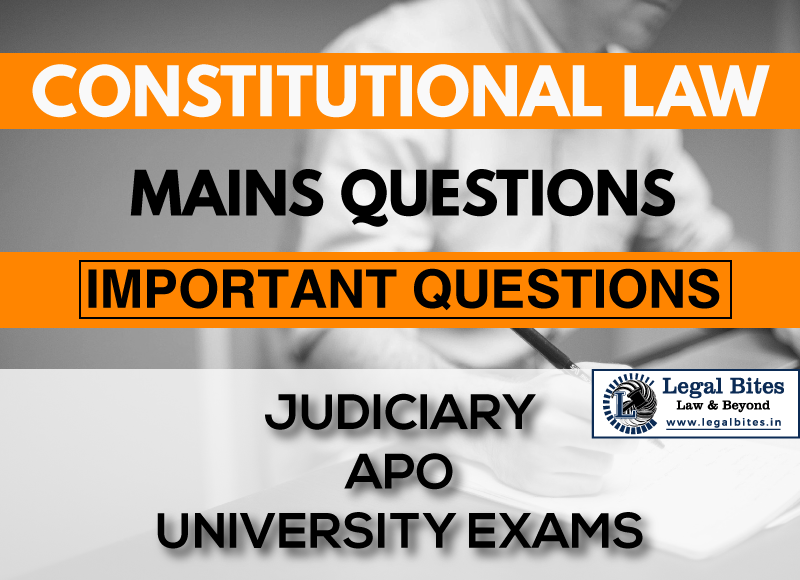What is Public Interest Litigation? How has it helped the Supreme Court in protecting fundamental rights in India?
Question: What is Public Interest Litigation? How has it helped the Supreme Court in protecting fundamental rights in India? [BJS 2000, 2006, MPJS 2016] Find the answer to the mains question only on Legal Bites. [What is Public Interest Litigation? How has it helped the Supreme Court in protecting fundamental rights in India?] Answer Public interest Litigation (PIL)… Read More »

Question: What is Public Interest Litigation? How has it helped the Supreme Court in protecting fundamental rights in India? [BJS 2000, 2006, MPJS 2016] Find the answer to the mains question only on Legal Bites. [What is Public Interest Litigation? How has it helped the Supreme Court in protecting fundamental rights in India?] Answer Public interest Litigation (PIL) means litigation filed in a court of law, for the protection of “Public Interest”, such as Pollution, Terrorism, Road...
Question: What is Public Interest Litigation? How has it helped the Supreme Court in protecting fundamental rights in India? [BJS 2000, 2006, MPJS 2016]
Find the answer to the mains question only on Legal Bites. [What is Public Interest Litigation? How has it helped the Supreme Court in protecting fundamental rights in India?]
Answer
Public interest Litigation (PIL) means litigation filed in a court of law, for the protection of “Public Interest”, such as Pollution, Terrorism, Road safety, Constructional hazards, etc. Any matter where the interest of the public at large is affected can be redressed by filing a Public Interest Litigation in a court of law.
Public interest litigation is the power given to the public by courts through judicial activism. However, the person filing the petition must prove to the satisfaction of the court that the petition is being filed for public interest and not just as a frivolous litigation by a busy body.
The court can itself take cognizance of the matter and proceed suo motu or cases can commence on the petition of any public-spirited individual. A PIL can be initiated by any public-spirited person or group on behalf of any aggrieved. Thus the locus standi is liberally construed in the field of PIL to allow standing to any pro bono public.
The first reported case of PIL was Hussainara Khatoon v. State of Bihar (1980 1 SCC 98) that focused on the inhuman conditions of prisons and under-trial prisoners that led to the release of more than 40,000 under trial prisoners. The right to speedy justice emerged as a basic fundamental right that had been denied to these prisoners. The same set pattern was adopted in subsequent cases.
According to the jurisprudence of the Constitution of India, “The right to move the Supreme Court by appropriate proceedings for the enforcement of the rights conferred by this Part is guaranteed.” Ordinarily, only the aggrieved party has the right to seek redress under Article 32.
However, Justice PN Bhagwati in the landmark judgment SP Gupta v. Union of India (AIR 1982 SC 149), expressly articulated that when a legal right has been breached and the individual is unable to approach the court for relief, any member of the public can maintain an application for an appropriate direction, both with the Supreme Court and the High Court.
In keeping with the spirit of PIL, which is to increase access to justice, there are a few conditions that a petition must meet:
- The complaint cannot be against a private party
- It must be a bonafide complaint that is not frivolous in nature.
Within this broad framework, PILs have emerged as a powerful tool in the hands of the people. The courts have even accepted letters and telegrams as petitions. Therefore, evidently, PIL has served to facilitate judicial innovations by the Supreme Court to help the poor and marginalized and protect their fundamental rights. It is an important instrument of social change for the welfare of every section of society.
The innovation of this legitimate instrument proved beneficial for developing countries like India where PIL has been used by the Supreme Court as a strategy to combat the atrocities prevailing in a society like a ban of smoking in public places, a right against sexual harassment at workplaces, right to clean and pollution-free environment. For instance, in the Bandhua Mukti Morcha v. Union of India [1984 SCC (3) 161], the Supreme Court put the burden of proof on the respondent stating it would treat every case of forced labor as a case of bonded labor unless proven otherwise by the employer.
Important Mains Questions Series for Judiciary, APO & University Exams
- Constitutional Law Mains Questions Series Part-I
- Constitutional Law Mains Questions Series Part-I
- Constitutional Law Mains Questions Series Part-II
- Constitutional Law Mains Questions Series Part-IV
- Constitutional Law Mains Questions Series Part-V
- Constitutional Law Mains Questions Series Part-VI
- Constitutional Law Mains Questions Series Part-VII
- Constitutional Law Mains Questions Series Part-VIII
- Constitutional Law Mains Questions Series Part-IX
- Constitutional Law Mains Questions Series Part-X
Admin Legal Bites
Legal Bites Study Materials correspond to what is taught in law schools and what is tested in competitive exams. It pledges to offer a competitive advantage, prepare for tests, and save a lot of money.
